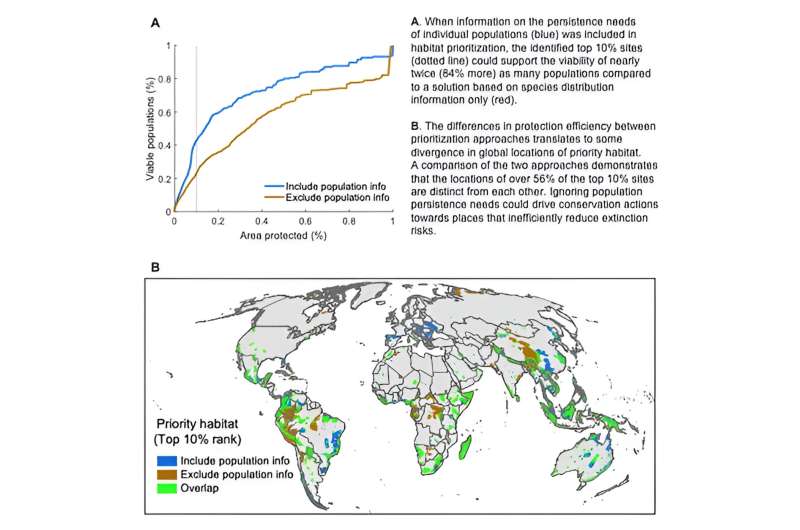
Credit: International Institute for Applied Systems Analysis
Amid an alarming surge in global habitat destruction and species extinction, new research by an international team of scientists proposes a new global approach to choosing protected lands that could reduce species extinction risk twice as efficiently as current methods.
Protecting key ecosystems and habitats is widely accepted as being one of the most important actions to address species extinction. However, a point of contention arises when trying to calculate ecological value and to decide which areas are prioritized for protection first, to provide maximum benefit to the greatest number of at-risk species. The study argues that current land prioritization practices fall short, excluding localized data fundamental to understanding how a species interacts with the habitats in its global distribution.
“The global extinction of a species begins locally, occurring one population at a time, and individual populations can be more or less resilient depending on regional factors like land use or management intensity,” explains lead author Nicholas Wolff, Director of Climate Science at The Nature Conservancy (TNC). “We need a prioritization model that reflects those core tenets of ecology.”
The coalition of researchers sought to prove there was a better and more effective approach that governments and practitioners allocating lands for conservation could use in the future. Rather than determine land prioritization based solely on species range and richness—as has historically been the case—the study modeled what would happen if conservationists also incorporated population-level info, such as the growth rates and habitat needs of every individual population of a species, focusing on terrestrial mammal species. The results were eye-opening.
“We found that 80% of the planet’s ‘priority habitats for persistence’—in other words, the areas that mammals threatened with extinction depend upon most for their survival—are not currently protected and only 7.9% is strictly protected,” notes study co-author Piero Visconti, who leads the Biodiversity, Ecology, and Conservation Research Group in the IIASA Biodiversity and Natural Resources Program.
“To our knowledge, this is the first study where the identified priority areas maximize not just global biodiversity representation, but also persistence at this spatial scale and detail,” adds Heini Kujala, co-author and University Researcher at the Finnish Natural History Museum. “We hope the findings encourage innovation in conservation strategies worldwide and contribute to the global fightback against accelerating extinction rates.”
The study, published in One Earth, identified a number of habitats where strengthening existing conservation protections has the potential to bring about a significant reduction in global extinction risk for a greater number of species. Notably, the results show that just seven countries—Australia, Brazil, China, Indonesia, Madagascar, Mexico, and Papua New Guinea—contain over half of Earth’s surviving priority habitats for species persistence, providing ample potential for trialing the new approach proposed by this study.
The results are already being put to use at TNC, the largest biodiversity conservation NGO globally, helping to pinpoint “Last Chance Ecosystems,” prioritize conservation focal areas and inform strategy organization-wide.
More information:
Nicholas Wolff et al, Prioritizing global land protection for population persistence can double the efficiency of habitat protection for reducing mammal extinction risk, One Earth (2023). DOI: 10.1016/j.oneear.2023.10.001. www.cell.com/one-earth/fulltex … 2590-3322(23)00451-7
Citation:
Prioritizing land to avoid species loss could reduce species extinction risk twice as efficiently (2023, November 17)
retrieved 18 November 2023
from https://phys.org/news/2023-11-prioritizing-species-loss-extinction-efficiently.html
This document is subject to copyright. Apart from any fair dealing for the purpose of private study or research, no
part may be reproduced without the written permission. The content is provided for information purposes only.
>>> Read full article>>>
Copyright for syndicated content belongs to the linked Source : Phys.org – https://phys.org/news/2023-11-prioritizing-species-loss-extinction-efficiently.html










